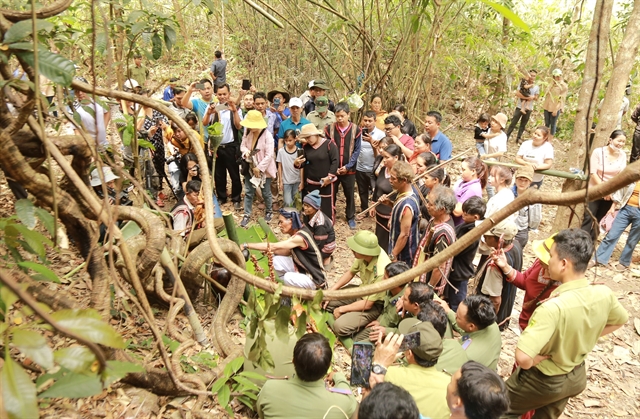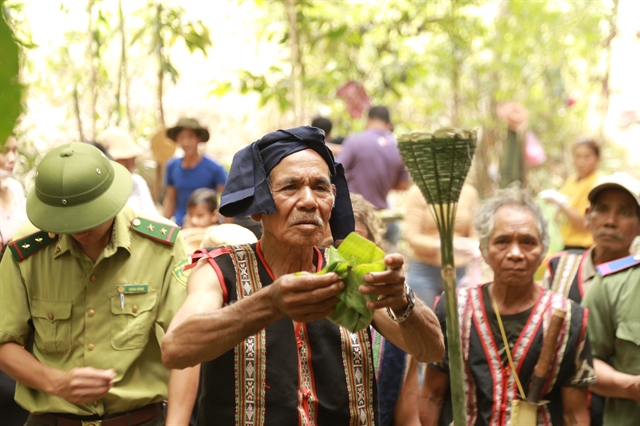Weather:
- Ha Noi 32oC
- Da Nang 28oC
- Ho Chi Minh 33oC

For ethnic minorities in the Tây Nguyên (Central Highlands) and mountainous regions across the country, the forest does not simply refer to materials and resources, but also a broad spiritual culture.
Forest worship practices have existed in the consciousness and life of ethnic minorities for a long time, featured in local ceremonies and festivals based on concepts of the universe and animism and represented by sacred forest gods.
Among them is the religious practice of cúng rừng (forest god worship) of the Jrai community in the Central Highlands province of Gia Lai. The event is a major tradition showing attachment to Mother Nature.

Cúng rừng is a ceremony held to worship the Forest God, but also for locals to pray for good health as well as a bumper harvest. The Jrai people organise it to thank Forest God for protecting the villagers and providing all that is under the forest canopy, as well as to educate the young generation about forest conservation and protection.
Every year, after local villagers complete the harvest in late March, groups of Jrai people in Ia Pếch Commune, Ia Grai District, including old and young, women and men, girls and boys, follow each other on a small path leading deep into the forest to attend cúng rừng.
They bring many offerings to the worship altar in the heart of the forest, which has been carefully chosen by a local shaman.
This year, cúng rừng took place next to a small stream named Ia Cor – about 1km from O Grang Village. The spot was chosen by Siu Dơih, a village elder.
It began at 10:30am in the presence of the villagers from De Chi and O Grang, local authorities and forest rangers. Under shaggy wooden vines Dơih – the celebrant –prepared an offering tray of roasted pig, chicken, grilled meat, wine, chicken liver and a piece of raw pork.
He prayed to invite the Forest God, the Mountain God, and the Water God to attend the ceremony, receive the offerings and protect the villagers, so they could have a peaceful and prosperous life.

According to the tradition of the Jrai, the forest worship ceremony is held simply, without the beating of gongs. Offerings also depend on the local conditions that year.
Rượu cần, a kind of wine stored in a big jar and drunk with long bamboo straws, is given alongside a tray of other offerings.
Dơih in his Jrai ethnic costume, on behalf of the villagers, solemnly read the prayers including wishes that the forest protect the villagers from natural disasters. He thanked the Forest God for supporting them in the past year.
Dơih said in recent years, the Forest God has helped their life change and bring more prosperity, happiness and safety. To give thanks, the village prepared more roasted pigs to offer to their god.
After Dơih finished his prayer, other senior villagers and elderly continued the ritual.
The Forest God worship ceremony is a long-standing practice that has been passed down from generation to generation in the Jrai community.
Practised for centuries, the ceremony has contributed to the richness of the country’s traditional cultural values and particularly to natural forest conservation.
In Ia Pếch Commune, nearly 560 hectares is covered by forest under the management and protection of O Grang and De Chi villages.
The two villages take turns in holding the ceremony each year, which is also intended to enhance the solidarity between the Jrai people in different villages, according to the local authority.
Ngô Khôn Tuấn, chairman of the People's Committee of Ia Pếch, said through Forest God worship practices, the people had improved their awareness of forest protection.
"They love the forest even more, thereby participate more in educating others to join hands to protect it," Tuấn said.
Over the years, forest preservation had been implemented well by villagers from De Chi and O Grang. The commune set up a forest management and protection team to work with them to boost forest protection.
"The forest protection work in the commune achieves great results. Besides protecting existing forest areas, the locals have also joined hands in contracting afforestation," Tuấn said.
Đích Ích Hiệp, head of the Ia Grai District Forest Protection Division, was pleased to report that forest management and protection was a bright spot of the local community.
"People have greatly supported our functional forces in patrolling, controlling and planting trees," he said.
Meanwhile, Đào Lân Hưng, vice chairman of the Ia Grai District's People's Committee, said the district had paid attention to cultural and spiritual activities associated with forest protection for many years.
The district pledged to continue to expand the cúng rừng ceremony in various communes, especially areas recognised as hot spots of forest encroachment.
It is thought it could help replicate the model of forest protection so that people could cooperate in strengthening the management of the forest, according to Hưng
The cúng rừng ritual of the Jrai people is not only a cultural feature of an agrarian polytheistic philosophy, but it also affirms the values of the community: "Living in the forest and sharing a common sense of protecting Mother Nature and the wider ecology." VNS


